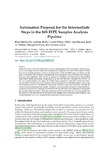Automation Proposal for the Intermediate Steps in the 16S FFPE Samples Analysis Pipeline

Use this link to cite
http://hdl.handle.net/2183/34155
Except where otherwise noted, this item's license is described as Attribution 4.0 International (CC BY 4.0)
Metadata
Show full item recordTitle
Automation Proposal for the Intermediate Steps in the 16S FFPE Samples Analysis PipelineAuthor(s)
Date
2023Abstract
[Abstract] In the day-to-day work of bioinformatics, the use of integrated software packages, which encompass
a wide range of tools, enables the development of pipelines for omics data analysis. Within
the various existing pipelines, we focus on the analysis of the 16S rRNA gene as it allows for the
study of diversity and taxonomy of prokaryotic microorganisms such as Bacteria and Archaea.
However, these pipelines often involve a sequence of multiple tools that require intermediate
steps before further processing can proceed, as in the case between Cutadapt and DADA2. In
fact, in a typical pipeline, the values for DADA2 input arguments ’trunc-len-f’ and ’trunc-len-r’
are extracted from the output of Cutadapt. The best approach for selecting optimal values (aka
the trimming positions) is graphically visualizing Cutadapt output and manually selecting the
most accurate trimming position length. Therefore, we propose the automation of this specific intermediate
step between Cutadapt and DADA2 tools, by selecting values displayed in the graphs
that meet the filtering criteria. This automation has been incorporated into a custom pipeline for
the analysis of the microbiome in 16S paired-end samples from colorectal cancer patients, and
could potentially serve as a standardization approach in these processes
Keywords
Bioinformática
Análisis de datos ómicos
DADA2
Cutadapt
Análisis de datos ómicos
DADA2
Cutadapt
Description
Cursos e Congresos, C-155
Editor version
Rights
Attribution 4.0 International (CC BY 4.0)






